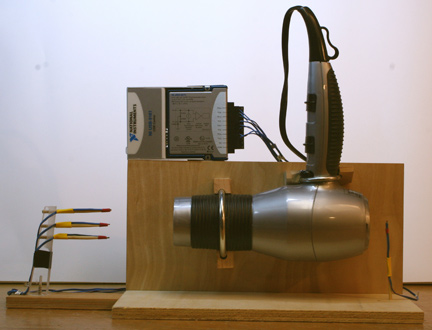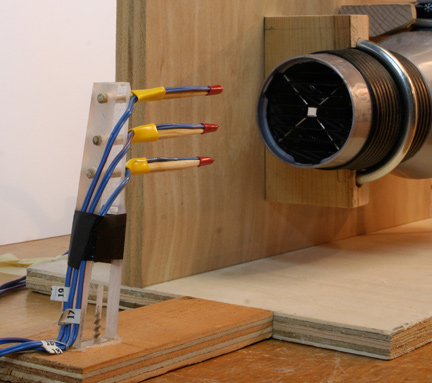The Hair Dryer Experiment
Apparatus
The apparatus consists of a hair dryer, thermocouple probes, a data acquisition system (DAQ), and a computer to record the data captured by the data acquisition system. Figure 1 is a schematic of the entire apparatus. Figure 2 is a photograph if the hair dryer, DAQ, and thermocouples.

Figure 1: Schematic of the hair dryer experiment.
The hair dryer is mounted on a small plywood frame The air exits horizontally about 10 cm from the surface of the supporting table.

Figure 2: Hair dryer, thermocouple sensors, and data acquisition system.
Three thermocouples are mounted on slender bamboo sticks (barbecue skewers) inserted into a piece of acrylic, which is screwed to a small piece of plywood. The probe assembly can be moved about the table so that air temperature as a function of position can be recorded. For the in-class demonstration and for the basic laboratory exercise, the position of the downstream probes is fixed.

Figure 3: Support for thermocouple sensors downstream of the hair dryer.
The data acquisition system is a NI USB-9211A device from National Instruments that can read up to four thermocouples. The DAQ device is controlled by a LabVIEW program running on the computer. The program collects the temperature readings, plots the temperature values in a strip chart, and stores the data for later analysis.
In-class Demonstration
The in-class demonstration takes 15 minutes, including the time to introduce the project, fill out the worksheets, and run the experiment.
The demonstration begins with a brief introduction to the EET project and a description of the experimental apparatus. Students are asked to complete a one page worksheet that solicits their prediction of what will happen when the fan speed increased while the temperature setting is held constant. The students are asked to predict whether the temperature of the downstream thermocouples will increase, decrease, or stay the same. Other questions on the worksheet ask the students to provide some justification for their prediction, and to identify the physical principle and mathematical model for the temperature response.
Lab Exercise
The laboratory exercise takes about one and a half hours. The purpose of the exercise is to give students a guided-inquiry learning experience that complements the conventional lecture for the class. At this point in the EET research project the team is developing the laboratory hardware and learning exercise. As such, the lab exercise is voluntary and does not count toward the student's grade in the course.
The first three pages of the lab manual provide an introduction to the analysis models used in the lab to study the performance of the hair dryer. It would be good to study those pages before coming to the lab.
